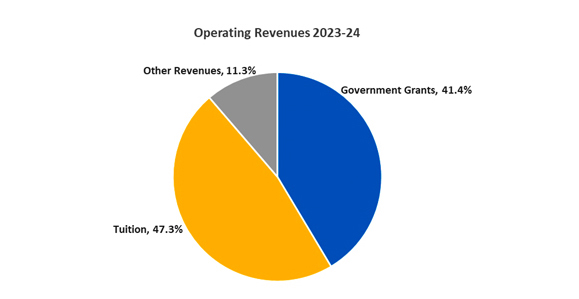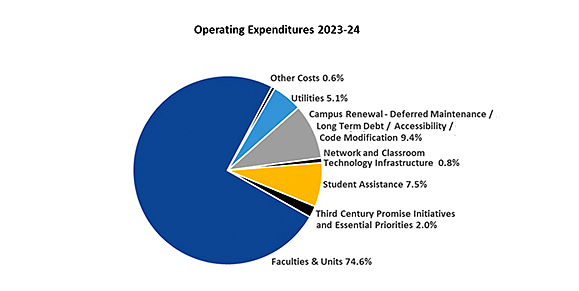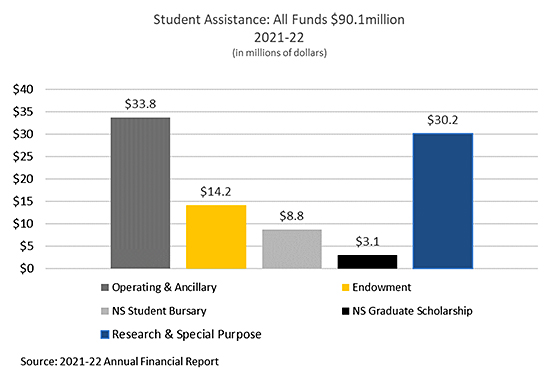Each year, Dalhousie’s Budget Advisory Committee, or “BAC,” invites input from the Dal community on budget priorities and pressures and produces a draft operating budget for feedback.
With this year’s draft plan now available, along with tuition and fee recommendations for the upcoming academic year, we thought we’d take aĚý look behind the numbers to help explain what all the dollars and cents add up to when it comes to supporting the university, its people and its overall mission.
What is the operating budget for?
As its name suggests, Dal’s operating budget funds the day-to-day operations of the university. This includes:
- Paying faculty and staff salaries, along with benefits and pension payments
- Providing funding allocations to Faculties and Units to support their operations
- Maintaining and updating buildings and classrooms
- Student financial assistance (scholarships and bursaries)
- Utilities expense (energy, water, taxes, etc.)
- Library acquisitions
- Allocations to support strategic university priorities
In total, approximately 70% of Dal’s overall financial activities (total revenues and expenditures) are funded by the operating budget.
How large is the operating budget?
For this current budget year (2022-23), Dal’s operating budget was set at $516.7 million. The draft budget plan for 2023-24 has that number rising to $557.8 million.
What is not covered by the operating budget? Ěý
The rest of Dal’s financial business is conducted through a group of other funds restricted for their particular use — for example, research (where grants for research projects are managed), endowment (funds raised from donors), ancillary (cost-recovery functions like residence and food services) and capital (property, plant and equipment).
In most of these cases, these funds cannot be used on operating expenses. Only the endowment fund is typically able to provide some support to operating expenditures.
Where does the money come from to fund Dal’s operating budget?
Most of the operating budget comes from just two sources: an annual grant from the provincial government and tuition fees paid by students. The following is an estimate of what this breakdown is expected to look like for this upcoming fiscal year (2023-24):

The roughly 10% or so in the “other” category comes from several smaller sources, most significantly from the university’s endowment. The endowment — funds provided by donors to the university — generates investment income for the operating budget, though not at the scale of government and tuition revenue. (In 2023-24, this endowment revenue is expected to total $43.6 million, or about 7.8% of the budget.)
What does Dal spend its money on?
Nearly three-quarters of the budget is distributed to Faculties and Units to spend on their people and priorities.
Most of the remainder of spending is allocated for campus renewal (facilities upgrades and upkeep), accessibility and code upgrades, student assistance, utilities, IT, and strategic priorities. In the draft budget plan, this breakdown looks like this:

By far the biggest expense Dal has is its people: salaries, benefits and pension costs for faculty and staff. Faculty and staff compensation represents nearly 70% of total spending.
Why do tuition fees go up each year?
The main reason is that each year it costs more to run the university and deliver Dal’s programs and supports — and these costs increase at a faster rate than Dal’s other revenue sources.
Next year, for example, government funding is set to increase by $2 million (a 0.4% increase to the overall budget). Support from Dal’s endowment funds will increase, contributing $6.5 million (0.7%). (This number includes research funds through the now-integrated Dalhousie Medical Research Foundation.)
But Dal’s operating costs increase by significantly more than this. In recent years, this number has averaged around 4-6% annually. This year it’s a bit higher: if no measures were taken to contain costs, Dal’s expenses would be set to increase by more than $46 million in 2023-24.
Dalhousie implements measures to contain these rising costs, as we’ll describe below. But tuition fees are a critical component in the mix of revenue sources that support the rising costs of operating the university.
Why do Dal’s costs increase each year?
Nearly everything in the operating budget typically requires continued and often increasing funding:
- Salaries, benefits and pension costs for faculty and staff increase each year, as outlined in collective agreements.
- Rising costs caused by inflation (in energy, library acquisitions, etc.).
- Maintenance and modernizing of buildings and classrooms.
- Upgrades to campus IT infrastructure and support.
- Student assistance.
What efforts are taken to reduce rising costs?
While some of the increasing costs are necessary investments or unavoidable expenses, Dal does take measures each year to constrain spending and find efficiencies to help balance the budget. Both last year and in this proposed budget, Faculties and Units are asked to absorb a 1.5% reduction in costs. Each Faculty or Unit handles this 1.5% gap in its own way —Ěýreducing expenses or adjusting costs in a way that makes sense for their individual goals and priorities.
Who makes the decisions about the operating budget?
Dalhousie has a Budget Advisory Committee, which is chaired by the Provost and with membership from administrative units, academic faculty, and student body. Its goal is to consult broadly with the Dal community and to produce a budget plan to bring forward to the university’s Board of Governors.
It’s the Board that ultimately approves the budget plan for the university, which it’s scheduled to do in March.
What is in next year’s draft budget plan?
You can review the full draft budget plan at dal.ca/budget, but it includes:
- An increase to Faculty/unit budgets of $24.2 million (an average of 5.1%). Faculties and units will be asked to address a 1.5% gap between this budget allocation and overall cost increases.Ěý
- An increase to domestic tuition of 3%. Current international students would see their tuition increase, on average, by 7.5% — a comparable increase to recent years. As previously communicated and as approved by the Board in the fall, a new guaranteed tuition model will apply to new international undergraduate students beginning Fall 2023.Ěý
- An increase to student assistance of $1.1 million, including an allocation to support international students under the new tuition model.Ěý
- $4 million increase to facilities renewal funding for buildings and classroom spaces.
- An additional $4 million focused on two key space priorities: dedicated funding for projects outlined in Dal’s Accessibility Plan, and investments needed to meet code requirements
- New investments in cybersecurity and research security
- $3.75 million towards initiatives in Dal’s strategic plan, Third Century Promise, and other essential priorities.
- An inflationary adjustment of 2%Ěýapplied to Faculty/Unit non-salary budgets, library acquisition costs, and network and classroom tech infrastructure funding.
How are tuition increases set?
Dal strives to keep tuition rates competitive with other Canadian universities while appropriately reflecting and supporting the continued quality of its academic programs.
Dalhousie’s domestic tuition has been increasing by 3% annually for several years now and is planned to do so again next year. This is the limit to which tuition for Nova Scotian students can be raised under the current Memorandum of Understanding with the province.
For returning international students, the BAC is recommending a percentage increase that will average 7.5% —Ěýresulting in an increase comparable to those over the past four years. Earlier this year, the Board approved a new guaranteed tuition model for international undergrads beginning their studies this fall.
How does Dal invest in student assistance?
Through student assistance, Dalhousie helps attract a diverse mix of outstanding students, rewards high academic achievement, and supports students in historically and currently underrepresented groups. The BAC also considers student assistance as a critical complement to rising tuition fees: “For example,” the BAC writes, “a $1.0 million decrease in tuition fees for all students would save on average less than $50 a year for each student, while $1.0 million provided in bursary support provides significant assistance to those students in greatest financial need.”
Dalhousie spends 9% of operating expenses on student assistance — well above the U15 average and more than all but one other U15 school. In 2021-22, Dalhousie spent $33.8 million in operating funds on scholarships and bursaries. But this is only part of the student assistance available. Across all funds, Dal spends more than $90 million each year on direct student support.

The draft operating budget plan for 2023-24 proposes a $1.1 million increase to student assistance from the operating budget.
What if I have thoughts on the proposed budget plan?
The Dalhousie community is invited to provide feedback on this draft Operating Budget Plan, as well as tuition and auxiliary fee increases. You can learn more at dal.ca/budget. Students, faculty and staff should check their Dal email for links to the feedback survey, and thoughts can also be emailed to BAC@dal.ca.

